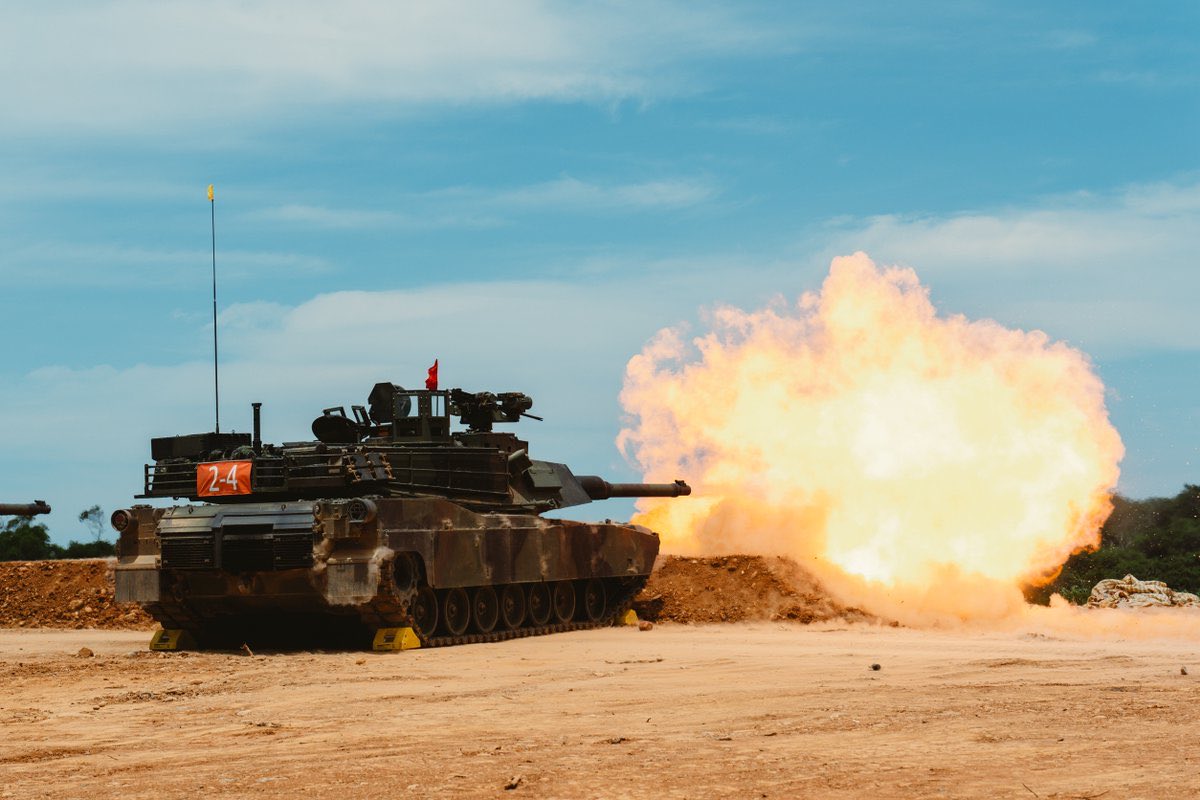Abrams Tanks, NMESIS Missiles “Thunder’ In China’s Backyard As Taiwan & Philippines Flaunt U.S. Weapons To Deter PLA

The Republic of China (better known as Taiwan) officially kicked off the annual Han Kuang military exercise on July 9, with a special emphasis on combating China’s ‘grey zone’ tactics that are classified as acts of aggression, little short of a war.
On its part, China considers Taiwan a renegade Chinese province and has vowed to seize it, with force if necessary.
The Chinese People’s Liberation Army (PLA) forces routinely conduct military drills in the Taiwan Strait and simulate an invasion that involves encircling Taiwan and cutting it off from the rest of the world.
In recent times, the intensity and frequency of this military intimidation have increased, necessitating an adequate military response from Taiwan. This is, perhaps, why the Han Kuang exercise is being conducted over 10 days, as opposed to the regular 5 days.
On July 10, the second day of the drills, the Taiwanese Army displayed the US-origin M1A2T Abrams tanks.
According to reports in local media, four Abrams tanks were seen manoeuvring across a mud-strewn army training site in Hsinchu county while firing at both stationary and moving targets.
The Abrams firing was overseen by Taiwanese President Lai Ching-te, who later stated that “every increase in the military’s combat power, the nation and its people gain an extra layer of security.”
“Whether in terms of strike capability or mobility, it was extremely powerful — undoubtedly the strongest tank on the battlefield,” he asserted.
The first batch of 38 US-origin M1A2 tanks from a 108-unit order reached the Port of Taipei in New Taipei’s Bali District in December 2024. The next order, consisting of approximately 42 tanks, is scheduled for delivery this year, with the remaining 28 tanks to be delivered over the next year.
As per previous reports, the Army intends to commission the M1A2T tanks in the second half of 2025.
Although Taipei generally focuses on asymmetric warfare, the Abrams are an important plank of its defense. Experts state that while any cross-strait conflict will take place on the sea and in the air, Taiwan would still need significant ground-based firepower to attack Chinese tanks that might invade the island state.
Moreover, the capability of these cutting-edge tanks to shoot from mountaintops will be essential in thwarting an invasion.
Taiwan’s existing tank fleet, comprising M60A3s and CM-11s, has been in service for over 30 years and is considered outdated in comparison to modern PLA capabilities. The M1A2T represents a significant upgrade, replacing these older models and enhancing Taiwan’s ground-strike and fire-support capabilities.

While these tanks would be instrumental in repelling Chinese amphibious landing attempts, they would have to be protected against cheap, expendable drones.
President Lai said that using “realistic combat training,” the M1A2T tank will “be able to integrate with drones and innovative tactics to more effectively fulfill the nation’s strategic objectives.” However, the live-fire test with Abrams was not a formal component of the drills, which are intended to simulate complete combat situations at sea, on land, and in the air, according to military sources.
The Taiwanese Han Kuang drills are only about to get more interesting from here, with a host of exercises aimed at deterring a Chinese invasion planned. Meanwhile, the Philippines and the US wrapped up their joint military drills, which took place in China’s backyard.
The US & Philippines Used The NMESIS In Balikatan
The Philippines has emerged as the frontline state in this sustained US-China rivalry unfolding in the Indo-Pacific, as Manila finds itself at the receiving end of sustained Chinese aggression in the South China Sea.
The Philippines is a treaty ally of the US, with the latter bound by the Mutual Defense Treaty to defend the Philippines, which is part of the first island chain — the strategic archipelagos in East Asia comprising Taiwan, Japan, and the Philippines.
The US has anchored the Chinese intimidation of the Philippines by meticulously deploying its own military assets in the country to deter Beijing. This includes the NMESIS, which was deployed to the Southeast Asian country for the Balikatan 2025 military exercise—the largest joint military exercise ever conducted between the two states.
The US Pacific Fleet reported on July 10 that the Navy-Marine Expeditionary Ship Interdiction System (NMESIS) missile system was used in a test fire in the Philippines during the Balikatan 2025 drills.
However, the fleet later clarified that while the system was deployed for the drills, no missiles were fired.
A spokesperson for the US Pacific fleet said Adm. Steve Koehler, the commander of the Pacific Fleet, “imprecisely stated in his speech” at a military leadership event in Manila on July 10, that the US test-fired NMESIS missiles during the joint military exercises.
“The NMESIS was deployed during Balikatan and took part in battle drills, but no missiles were fired,” the spokesperson said in a statement.

NMESIS is a ground-based missile system that can hit adversary surface ships from a distance of about 100 nautical miles. This is the second American missile system to be deployed to the Philippines for military drills, following the Typhon missile system.
The US placed the system in key sites around Northern Luzon and the Batanes Islands during the April 21–May 9 Balikatan exercises in what was the first-ever staging of the “ship killer” missile system in the Philippines.
Even though the system did not test fire a missile, the location of its deployment is still of strategic interest. The Philippines and Taiwan are merely separated by Luzon Strait, a deep channel connecting the South China Sea to the Philippine Sea.
A vital choke point for ships sailing between the western Pacific and the South China Sea, the Bashi Channel is a section of this strait that connects Taiwan and the Batanes Islands in the Philippines.
A part of this strait, the Bashi Channel runs between the Philippines’ Batanes Islands and Taiwan and is a crucial choke point for ships traveling between the western Pacific and the South China Sea.
China is expected to use the channel in the event of an invasion. Thus, the deployment of the NMESIS to this location sparks speculation that it may be a subtle message to deter Beijing.
Additionally, the Philippine Navy spokesperson, Capt. John Alcos informed reporters last month that the NMESIS system is still in the Philippines and will be used for training by the Philippine Marine Corps.
It remains to be seen whether the NMESIS will be withdrawn in the future or remain indefinitely in the country, similar to the Typhon.
- Questions and Answers
- Opinion
- Motivational and Inspiring Story
- Technology
- Live and Let live
- Focus
- Geopolitics
- Military-Arms/Equipment
- Security
- Economy
- Beasts of Nations
- Machine Tools-The “Mother Industry”
- Art
- Causes
- Crafts
- Dance
- Drinks
- Film/Movie
- Fitness
- Food
- Games
- Gardening
- Health
- Home
- Literature
- Music
- Networking
- Other
- Party
- Religion
- Shopping
- Sports
- Theater
- Health and Wellness
- News
- Culture

